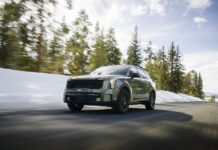NORTHBROOK, Illinois, Nov. 14, 2018 /PRNewswire-HISPANIC PR WIRE/ — Four of the country’s top 10 safest cities for driving in wet weather are in Texas, according to the 2018 Allstate America’s Best Drivers Report®i. With large swaths of the Southern United States in store for a wetter-than-average winter, according to the National Oceanic and Atmospheric Administrationii, those rankings could be put to the test during the holiday travel season and beyond.
This second installment of the 2018 America’s Best Drivers Report, announced today, ranks the country’s largest 200 cities to determine which have the safest drivers when precipitation is part of the equation. This year’s top spot goes to Brownsville, Texas, reclaiming the honor from two years ago after dropping to second last year.
“You may be surprised to know that even in warmer climates, winter weather can create dangerous driving conditions, making it more important than ever to be vigilant behind the wheel and aware of how rain and snow can impact roads,” said Ken Rosen, Allstate’s chief claims officer. “Allstate releases the America’s Best Drivers Report each year to draw attention to the critical community issue of safe driving. By celebrating the safest driving cities and lending a hand in bottom-ranked cities, we want to help Americans protect themselves before they get on the roads this holiday season – and ultimately help save lives.”
These precipitation rankings are an extension of the standard America’s Best Drivers Report, released in August. To determine the precipitation factor, Allstate researchers use a predictive model that standardizes the rankings to account for the fact that weather conditions vary dramatically across the United States and affect roadway safety. Allstate is recognizing the top-performing cities in rain or snow and offering tips to help people across the country drive safely.
The top 10 safest-driving cities when precipitation is factored with collision frequency:
|
City & Average Annual |
NOAA 30-Year Average (inches/year) iii |
|
1. Brownsville, Texas |
27.4 |
|
2. Kansas City, Kansas |
39.1 |
|
3. Huntsville, Alabama |
54.3 |
|
4. Boise, Idaho |
11.7 |
|
5. Madison, Wisconsin |
34.5 |
|
6. Cape Coral, Florida |
57.1 |
|
7. Laredo, Texas |
20.2 |
|
8. Midland, Texas |
14.8 |
|
9. Fort Collins, Colorado |
16.1 |
|
10. McAllen, Texas |
19.5 |
NOAA predicts a 70 to 75 percent chance of El Niño developing – making for a wet winter along the southern tip of the U.S. and into the Mid-Atlantic region. Warmer, drier conditions are anticipated for much of the northern and western parts of the country.
The biggest improvements and declines when precipitation is factored with collision frequency:
|
City |
Change in |
Precipitation |
NOAA 30-Year (inches/year) |
|
Biggest Improvement |
|||
|
Hollywood, Florida |
+17 spots |
93rd |
64.3 |
|
Pembroke Pines, Florida |
+15 spots |
86th |
67.1 |
|
Miramar, Florida |
+14 spots |
75th |
67.1 |
|
Hialeah, Florida |
+12 spots |
126th |
70.4 |
|
Pasadena, Texas |
+10 spots |
81st |
54.4 |
|
Biggest Decline |
|||
|
Las Vegas, Nevada |
-13 spots |
135th |
5.1 |
|
Riverside, California |
-11 spots |
136th |
12.4 |
|
Palmdale, California |
-11 spots |
110th |
7.4 |
|
Orange, California |
-10 spots |
133rd |
13.4 |
|
Henderson, Nevada |
-10 spots |
67th |
5.1 |
“NOAA’s annual winter weather outlook helps Americans to prepare for the possible dangers of the season and take precautions with their families and homes,” said Mike Halpert, deputy director of NOAA’s Climate Prediction Center. “A weak El Niño is anticipated to develop, and it may impact the winter season by bringing wetter conditions across parts of the southern United States, and warmer, drier conditions in parts of the North.”
It’s even more important to give yourself enough time to stop when roads are wet. According to the National Highway Traffic Safety Administration, braking distance on wet roads increases 27 percent versus stopping on dry roads when traveling at 55 mphiv – and that number increases when rain turns to snow or ice. Drivers can prepare for winter weather conditions by monitoring their driving with innovative telematics programs like Allstate’s Drivewise®, which Allstate uses to study the correlation between collisions and hard-braking events. Hard-braking events are defined as slowing down by 8 mph or more per second and can indicate unsafe driving behaviors, such as following too closely, or aggressive or distracted driving.
Here are other safety tips to help prevent a collision this holiday travel season and beyond:
- Do a systems check: Make sure your headlights and brake lights work, and check tires, heater, defroster, brakes, windshield wipers and windshield washer fluid level.
- Use an alternate route: Don’t drive through standing water on roads or in parking lots – it can stall your engine.
- Take it easy: Give yourself extra time to get where you’re going. Increasing following distance, traveling at slower speeds and accounting for extra stopping time will help avoid collisions.
- Stay alert: Give the road your undivided attention. That’s especially important with slick streets and other potentially dangerous conditions.
- Don’t panic: If your vehicle begins to slide or skid, don’t slam on the brakes. Look down the road in the direction you want to go and gently steer that way. Release the accelerator until traction returns.
- Have an emergency kit: Gloves, boots, blankets, flares, water, jumper cables, a flashlight and something for traction – like sand or cat litter – could all come in handy if a problem arises.
- Download Drivewise: Free to any consumer, Drivewise provides personalized, real-time driving feedback – such as how many hard-braking events you have – and allows you to earn rewards for safe driving.
In the 14th year of the America’s Best Drivers Report, Allstate is bringing attention to the critical community issue of safe driving in a new way. Allstate is encouraging youth to flip the script and take charge of this important conversation by advocating for safe driving among their parents, role models and friends.
To join the conversation, like and share the new Good Driving Starts Young Facebook page. And for more safe driving tips, check out The Allstate Blog.
iThe Allstate America’s Best Drivers Report® is the result of an in-depth examination of company claims data to determine the likelihood that drivers in America’s 200 largest cities will experience a vehicle collision compared to the national average. According to Allstate claims data, the average driver in the U.S. will experience one collision every 10 years. This year, Allstate researchers analyzed property damage claims reported during the two-year period of January 2015 to December 2016. The report uses U.S. Census Bureau data to determine America’s 200 largest cities and defines a collision as any auto crash resulting in a property damage claim. Hard-braking data is based on customers voluntarily enrolled in Allstate’s Drivewise® telematics program from 2015-2016. A number of cities, and their surrounding suburbs, in the full 200 Best Drivers’ rankings are excluded from hard-braking analysis due to limited measurable Drivewise data, or because Drivewise was not available (California, North Carolina, South Carolina and Texas). Allstate’s auto policies represent nearly 10 percent of all U.S. auto policies, making this report a realistic snapshot of what’s happening on America’s roadways. The Allstate America’s Best Drivers Report® is produced solely to boost the country’s discussion about safe driving and to increase awareness of the importance of being safe and attentive behind the wheel. The report is not used to determine auto insurance rates.
iiNational Oceanic and Atmospheric Administration, Winter Outlook favors warmer temperatures for much of U.S.
iii National Oceanic and Atmospheric Administration, Data Tools: 1981-2010 Normals. The method used for all cities is to utilize the weather data from the station closest to the city center.
ivNational Highway Traffic Safety Administration, Safety in Numbers Newsletter: August 2015.

PDF – https://mma.prnewswire.com/media/784396/2018_Best_Drivers_Winter_Precipitation_infographic.pdf?p=original
Logo – https://mma.prnewswire.com/media/378670/allstate_insurance_company_logo.jpg
SOURCE Allstate Insurance Company








